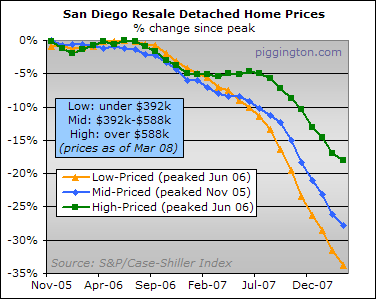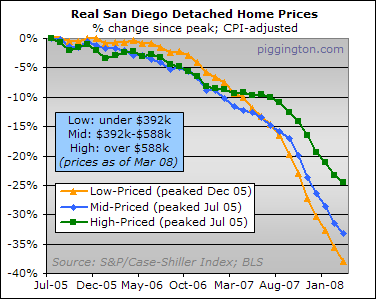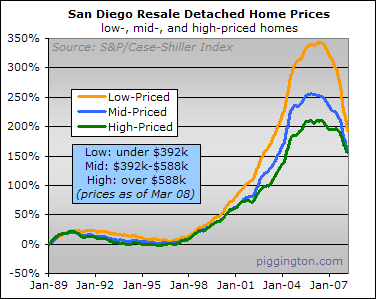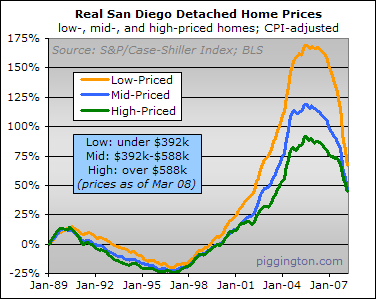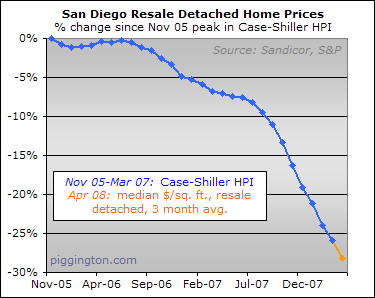By Kathleen M. Howley
May 27 (Bloomberg) -- U.S. Air Force Technical Sergeant Jeffrey VerSteegh, who repairs F-16 jets for the 132nd Fighter Wing, departed Des Moines, Iowa, in April for his third tour in Iraq. The father of four may lose his home when he returns.
The four-bedroom farmhouse he and his wife, Kathleen, own near the Iowa State Fairgrounds went into default in December after their monthly mortgage costs doubled to $1,100. Kathleen missed work because of breast cancer and they struggled to keep up the house payment, falling behind on other bills. Their bankruptcy was approved by the court a week after VerSteegh left for Iraq.
In the midst of the worst surge in mortgage defaults in seven decades, foreclosures in U.S. towns where soldiers live are increasing at a pace almost four times the national average, according to data compiled by research firm RealtyTrac Inc. in Irvine, California. As military families like the VerSteeghs signed up for the initial lower rates and easier terms of subprime mortgages, the number of people taking out Veterans Administration loans fell to the lowest in at least 12 years.
``We've never faced a situation like this, not in the Vietnam War, World War II, or the Korean War, where so many military are in danger of losing their homes,'' said Paul Sullivan, executive director of Veterans for Common Sense, a Washington-based advocacy group started in 2002 by Iraq and Afghanistan War veterans. ``No one asked them for their credit score when we asked them to fight for us.''
Military Foreclosures
Foreclosure filings in 10 towns and cities within 10 miles of military facilities, including Norfolk, Virginia, home of the Navy's largest base, rose by an average 217 percent from January through April from a year earlier. Nationally, the rate was 59 percent in the same period, according to RealtyTrac, which tallies bank seizures, auctions and default notices.
The biggest surge was in Columbia, South Carolina, home to Fort Jackson, where the Army trains recruits for combat in Afghanistan and Iraq. Properties in some stage of foreclosure rose 492 percent from a year earlier, RealtyTrac said. The second-biggest increase was 414 percent in Woodbridge, Virginia, next to the Marine Corps Base Quantico.
Foreclosure filings tripled in the cities surrounding Norfolk Naval Base and the Camp Pendleton Marine Corps Base near Oceanside, California, RealtyTrac said. Havelock, North Carolina, site of Marine Corps Air Station Cherry Point, saw foreclosures more than double.
Weak Credit
Military families were targeted as customers during the boom in subprime lending because their frequent moves, overseas stints, and low pay meant they were more likely to have weak credit ratings, said Rudi Williams of the National Veterans Foundation in Los Angeles. In 2006, at the peak of U.S. subprime lending, the number of VA loans fell to barely a third the level of two years earlier, according to VA data.
VA loans totaled 135,000 last year, its fourth consecutive annual decline.
An Army or Marine Corps sergeant with four years of experience makes $27,000 a year, plus combat pay of $225 a month, according to the 2008 Military Authorization Act, which increased basic pay rates 3.5 percent from a year ago.
Soldiers authorized to live off-base also receive a housing allowance that this year starts at about $500 a month, 7.3 percent higher than in 2007, paid even when they are deployed. Counting the stipends, they still fall short of the 2007 median U.S. household income of $59,224 as measured by the National Association of Realtors in Chicago.
Legislative Effort
``Think about how much stress comes with a foreclosure, and then imagine you're walking the same tightrope while being employed in Baghdad,'' said Paul Rieckhoff, 33, the head of Iraq and Afghanistan Veterans of America and a former 1st lieutenant with the Army's 3rd Infantry Division.
The Servicemembers' Civil Relief Act protects soldiers and sailors from losing homes for nonpayment of mortgages only while on active duty and for 90 days after they return home. Members of Congress, including Senator Johnny Isakson, a Georgia Republican, and Representative Bob Filner, a Democrat from California, are trying to extend that to a year, saying three months isn't enough.
Another flaw in the current law is it puts the burden on the soldiers, sailors or the families they left behind to come up with the paperwork and notify the bank, said Sullivan of the Washington Veterans' group. Unlike in other wars, members of the military often are able to telephone home or receive e-mails, creating a ``morale problem'' as they try to deal with foreclosure notices, he said.
VA Mortgages
``It's heartbreaking to see people struggling with a foreclosure while they or someone they love is in a war zone, or when they're trying to adjust after coming back from one,'' said Sullivan, a Cavalry Scout with the Army's 1st Armored Division during the 1991 Gulf War.
Lenders aren't required to keep records on the status of non-government loans to military members or veterans, said Mike Frueh, the VA's assistant director for loan management in Washington. Judging solely by data on VA mortgages, active military and veterans in the current housing slump are getting into trouble with their home loans at a pace only slightly above the civilian rate, he said.
The share of VA mortgages in foreclosure was 1.12 percent in the fourth quarter, compared with 0.96 percent for so-called prime borrowers with the highest credit scores, the Washington- based Mortgage Bankers Association said in a March 6 report.
`Stench of Death'
``My data comes from those that have VA loans, and we haven't seen, as I understand it, a big jump'' in foreclosures, said James Peake, the Secretary of Veterans Affairs in Washington, in a May 20 interview.
The increase may yet be coming: the share of VA loans with payments 30 days or more overdue was 6.49 percent in the fourth quarter, double the rate of 3.24 percent for prime borrowers. The share of VA mortgages more than 90 days overdue was 1.54 percent, also double the prime rate, according to the bankers' report.
Monique Kelly, a disabled Iraq War veteran, said she is on the verge of adding to those VA delinquency numbers. The former Army staff sergeant in the First Armored Division paid her May mortgage bill halfway through the month and said she won't be able to make June's payment for her house in Owings Mills, Maryland.
Kelly, designated disabled by the VA because of post- traumatic stress disorder, said she bought the property in January for $305,000 and had to spend $10,000 fixing structural problems that were not disclosed to her.
``We fought for our country, and now we have to fight to save our homes,'' said Kelly. ``After living with the stench of death in Iraq, it seems like we shouldn't have to face problems like this when we come back.''
Help for Veterans
The VA has nine regional loan centers in the U.S. that last year provided counseling for 85,000 veterans who had problems with government-backed mortgages, Frueh said. He said he contacted Kelly to see if he can help her.
Counselors also try to help veterans who fall behind on non- VA loans, he said, though they don't track the number of those cases.
``We will always try to intercede on a veteran's behalf,'' said Frueh. ``If they have a VA-guaranteed loan, we can do more for them.''
Military families or veterans refinancing a mortgage have limited resources for VA-backed loans, Frueh said. The government can only guarantee refinanced veteran loans up to $144,000, Frueh said. The median price of a U.S. home was $219,000 last year, according to the Chicago-based National Association of Realtors.
`No Hope'
The law gives military personnel the right to have interest rates temporarily lowered to 6 percent on loans incurred prior to entering active service. To apply for protection, they have to send copies of their military orders to their mortgage servicing companies, even if they are on the front lines. The VerSteeghs in Iowa didn't know about that option, said Kathleen.
Before leaving for Iraq, the 43-year-old VerSteegh called the Bush Administration's Hope Now program created to help people facing foreclosure, his wife said.
``We got no hope from Hope,'' and no information about the potential interest-rate deduction, according to Kathleen VerSteegh.
San Francisco-based Wells Fargo & Co., the servicer of the VerSteegh mortgage, removed the VerSteegh property from foreclosure in April after receiving a copy of the husband's active duty orders, said Debora Blume, a spokeswoman for the bank's mortgage unit, in an e-mailed statement. Kathleen VerSteegh, 42, said they weren't notified of the change. The mortgage had gone into foreclosure on Dec. 31, Wells Fargo said.
Refinancing Plans
Wells Fargo ``is working with Mrs. VerSteegh to reduce her monthly payment during this time of financial hardship,'' Blume said.
Like many U.S. borrowers who got adjustable mortgages, the VerSteeghs planned to refinance into a better loan before their initial rate of 6.45 percent, fixed for two years, reset in December 2006. U.S. home values began to decline about six months before their first adjustment.
The so-called margin, a fixed charge added to the loan's index to determine interest rate resets, is 5.25 percent, about double the typical margin for an adjustable mortgage. Their loan is indexed to Libor, the London Interbank Offer Rate.
``We refinanced so we could get new windows and do some work on the house,'' she said. ``We assumed we'd have no problem getting another loan, but then it blew up in our faces.''
Now they can't apply to refinance into a VA mortgage because they owe more on the house than it's worth and ``our credit is shot,'' said VerSteegh.
Bonus Army
The last time veterans lost homes to this extent was during the Great Depression, said Sullivan of Veterans for Common Sense. The so-called Bonus Army of almost 20,000 World War I ex-soldiers marched on Washington in June 1932 to demand early payment of certificates granted for service.
U.S. infantry and cavalry regiments under the command of General Douglas MacArthur attacked their encampment with bayonets and sabers to disburse them.
VerSteegh, who gets to speak to her husband by telephone for 15 minutes once a week, said she tries to reassure him that everything on the home front is going well, even as she struggles with the threat of foreclosure and her health problems. She's eight weeks into a course of chemotherapy treatments for breast cancer and had a double mastectomy on March 14.
VerSteegh said she doesn't know exactly where her husband is, just that he's somewhere near Baghdad.
``I don't tell him the whole story, because he has to focus on his job,'' she said. ``The guys in his unit are depending on him.''
Foreclosure Filings Near Military Bases from January to April, Compared With a Year Earlier:
Columbia, South Carolina: 492%
Woodbridge, Virginia: 414%
Triangle, Virginia: 363%
Oceanside, California: 182%
Norfolk, Virginia: 155%
Havelock, North Carolina: 133%
Carlsbad, California: 131%
Barstow, California: 120%
Columbus, Georgia: 102%
Twentynine Palms, California: 73%
U.S. Total: 59%





